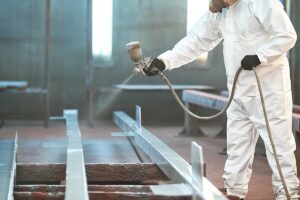Tackling corrosion may feel defeating. Using correct preventative measures can block, protect, and preserve your equipment from corrosion. Start your preventive corrosion maintenance by knowing which method(s) to use.
Corrosion Prevention Methods
- Use of non-corrosive metals
- Protective coatings
- Environmental considerations
- Corrosion inhibitors
- Sacrificial coatings
- Design adjustments
Use Non-Corrosive Metals
The most straightforward approach to avoiding, preventing, or blocking corrosion is using non-corrosive materials. Aluminum and stainless steel are both corrosion-resistant options that do not require corrosion protection.
Protective Coatings
One of the most cost-effective methods to prevent corrosion and extend your assets’ lifespan is applying proper protective coatings. Coatings and linings are preventative barriers against severe environmental, corrosion-causing conditions. Coatings limit the shift of electrochemical charge from the corrosive resistant coating to the metal it covers. The process slows down corrosion, allowing your equipment to continue functioning. Applying protective coatings does have associated costs. However, the cost to replace corroded equipment or parts far outweighs the costs associated with corrosion prevention.

Environmental Considerations
Reducing exposure to environmental factors can significantly prolong the lifespan of your assets. The chemical reaction that occurs between the metal from your equipment and the gases in the environment is the cause of corrosion. Reducing that exposure will help you take control of corrosion. Ensure your equipment is protected from rain, seawater, ice, dirt, and additional elements to assist in corrosion prevention. More extensive measures, such as treating all water in boiler tanks before running it through your equipment, can also prolong the life of your assets. Reducing the amounts of sulfur, oxygen, and chlorine in the environment surrounding your equipment will also increase the longevity of your property.
Corrosion Inhibitors
Applying chemicals to suppress electrochemical reactions on the surface of the metal can prevent corrosion. These chemicals create a protective film over the metal, acting as a barrier against corrosion-causing elements.
Sacrificial Coatings
Coating your equipment with metal materials more prone to oxidation will prevent corrosion to the equipment metal underneath. This coating is literally a “sacrificial coating.” The two types of sacrificial coatings are cathodic protection and anodic protection.
Galvanization is the most common application of cathodic protection. Because zinc is a more active metal than the steel it covers, the steel is protected from corrosion. When zinc begins to oxidize, corrosion to the steel is hindered. This process makes the steel the cathode of an electrochemical cell – hence, cathodic protection.
Anodic Protection uses a less active metal, such as tin, to coat the steel. Using a protective barrier metal over the steel prevents corrosion. Because tin will not rust, it protects the steel from corrosion as well. The steel becomes the anode of an electrochemical cell – hence, anodic protection.
Design Adjustments
Designing your facilities, equipment usage space, and project spaces can have an overall impact on corrosion. Ensuring water and air have free-flowing space, water is not trapped in or on any parts of your equipment, and dust and dirt do not have a chance to settle will help aid in the longevity of your assets.
Tell me the best method for preventing corrosion to my equipment.